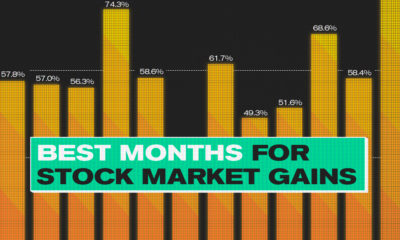Today’s chart of the Lassonde Curve outlines the life of mining companies from exploration to production, and highlights the work and market value associated with each stage. This helps speculative investors understand the mining process, and time their investments properly.
Making Cents of Miners: The Stages of a Mineral Discovery
In the life cycle of a mineral deposit, there are seven stages that each offer specific risks and rewards. As a company proves there is a mineable deposit in the ground, more value is created for shareholders along the way.
Case Study: The Oyu Tolgoi Copper-Gold Discovery, Mongolia
So now that you know the theoretical value cycle of a mineral discovery, how does it pan out in reality? The Oyu Tolgoi copper deposit is one recent discovery that has gone through this value cycle. It exemplifies some of these events and their effects on the share price of a company. At this stage, geologists are putting to the test a theory about where metal deposits are. They will survey the land using geochemical and sampling techniques to improve the confidence of this theory. Once this is complete, they can move onto more extensive exploration. Mineral exploration involves retrieving a cross-section (drill core) of the crust, and then analyzing it for mineral content. A drill core containing sufficient amounts of metals can encourage further exploration, which may lead to the discovery of a mineable deposit. Institutional and strategic investors can then use these studies to evaluate whether they want to advance this project. Speculators often invest during this time, known as the “Orphan Period”, while uncertainty about the project lingers. First, they must secure funding and build an operational team. If a company can secure funding for development, investors can see the potential of revenue from mining. However, risks still persist in the form of construction, budget, and timelines. Investment analysts will re-rate this deposit, to help it attract more attention from institutional investors and the general public. Meanwhile, existing investors can choose to exit here or wait for potential increases in revenues and dividends. But after 21 drill holes, the company lost interest and optioned the property to mining entrepreneur Robert Friedland and his company Ivanhoe Mines. At this point in 1999, shares in Ivanhoe were a gamble. Wild speculation began at this stage, as steadily improving drill results proved a massive copper-gold deposit in Mongolia and drove up the share price of Ivanhoe. Using this study, the company needed to secure enough money to build a mine to extract the valuable ore. It was not until two years later, when Ivanhoe Mines entered into an agreement with major mining company Rio Tinto, that a production decision was finalized. Further development work delineated a resource of 1.2 billion pounds of copper, 650,000 ounces of gold, and 3 million ounces of silver. This first stage of development for Oyu Tolgoi made Mongolia the world’s fastest growing economy from 2009 to 2011. It’s also worth noting there are still other risks ahead. These risks can include labor disruptions, mining method problems, or commodity price movement. Investors will have to consider these additional conditions as they pan out. While most mineral discoveries do not match it perfectly, the Lassonde Curve guides an investor through what to expect at each stage, and empowers them to time their investments right. on Last year, stock and bond returns tumbled after the Federal Reserve hiked interest rates at the fastest speed in 40 years. It was the first time in decades that both asset classes posted negative annual investment returns in tandem. Over four decades, this has happened 2.4% of the time across any 12-month rolling period. To look at how various stock and bond asset allocations have performed over history—and their broader correlations—the above graphic charts their best, worst, and average returns, using data from Vanguard.
How Has Asset Allocation Impacted Returns?
Based on data between 1926 and 2019, the table below looks at the spectrum of market returns of different asset allocations:
We can see that a portfolio made entirely of stocks returned 10.3% on average, the highest across all asset allocations. Of course, this came with wider return variance, hitting an annual low of -43% and a high of 54%.
A traditional 60/40 portfolio—which has lost its luster in recent years as low interest rates have led to lower bond returns—saw an average historical return of 8.8%. As interest rates have climbed in recent years, this may widen its appeal once again as bond returns may rise.
Meanwhile, a 100% bond portfolio averaged 5.3% in annual returns over the period. Bonds typically serve as a hedge against portfolio losses thanks to their typically negative historical correlation to stocks.
A Closer Look at Historical Correlations
To understand how 2022 was an outlier in terms of asset correlations we can look at the graphic below:
The last time stocks and bonds moved together in a negative direction was in 1969. At the time, inflation was accelerating and the Fed was hiking interest rates to cool rising costs. In fact, historically, when inflation surges, stocks and bonds have often moved in similar directions. Underscoring this divergence is real interest rate volatility. When real interest rates are a driving force in the market, as we have seen in the last year, it hurts both stock and bond returns. This is because higher interest rates can reduce the future cash flows of these investments. Adding another layer is the level of risk appetite among investors. When the economic outlook is uncertain and interest rate volatility is high, investors are more likely to take risk off their portfolios and demand higher returns for taking on higher risk. This can push down equity and bond prices. On the other hand, if the economic outlook is positive, investors may be willing to take on more risk, in turn potentially boosting equity prices.
Current Investment Returns in Context
Today, financial markets are seeing sharp swings as the ripple effects of higher interest rates are sinking in. For investors, historical data provides insight on long-term asset allocation trends. Over the last century, cycles of high interest rates have come and gone. Both equity and bond investment returns have been resilient for investors who stay the course.













